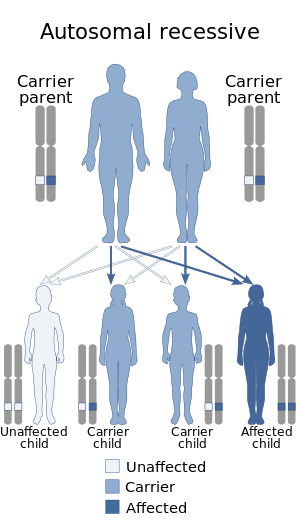Laurence–Moon syndrome
| Laurence–Moon syndrome | |
|---|---|
 |
|
| Laurence–Moon syndrome has an autosomal recessive pattern of inheritance | |
| Classification and external resources | |
| Specialty | medical genetics |
| ICD-10 | Q87.8 |
| ICD-9-CM | 759.89 |
| OMIM | 245800 |
| DiseasesDB | 30072 |
| MeSH | D007849 |
| Orphanet | 2377 |
Laurence–Moon syndrome (LMS) is a rare autosomal recessivegenetic disorder associated with retinitis pigmentosa, spastic paraplegia, and mental disabilities.
obesity, mental retardation,hearing loss, cataract, polydactyly, renal insufficiency, retinitis pigmentosa. .
LMS is inherited in an autosomal recessive manner. This means the defective gene responsible for the disorder is located on an autosome, and two copies of the defective gene (one inherited from each parent) are required in order to be born with the disorder. The parents of an individual with an autosomal recessive disorder both carry one copy of the defective gene, but usually do not experience any signs or symptoms of the disorder.
It is named after the physicians John Zachariah Laurence and Robert Charles Moon who provided the first formal description of the condition in a paper published in 1866. In the past, LMS has also been referred to as Laurence–Moon–Bardet–Biedl or Laurence–Moon–Biedl–Bardet syndrome, but Bardet–Biedl syndrome (BBS) is now usually recognized as a separate entity.
Recent advances in genetic typing of the phenotypically-wide variation in patients clinically diagnosed with either Bardet-Biedl Syndrome (BBS) or Laurence-Moon Syndrome (LMS) have questioned whether LMS and BBS are genetically distinct. For example, a 1999 epidemiological study of BBS and LMS reported that "BBS proteins interact and are necessary for the development of many organs." "Two patients [in the study] were diagnosed clinically as LMS but both had mutations in a BBS gene. The features in this population do not support the notion that BBS and LMS are distinct." A more recent 2005 paper also suggests that the two conditions are not distinct.
...
Wikipedia
